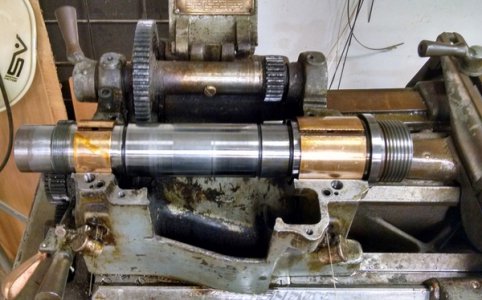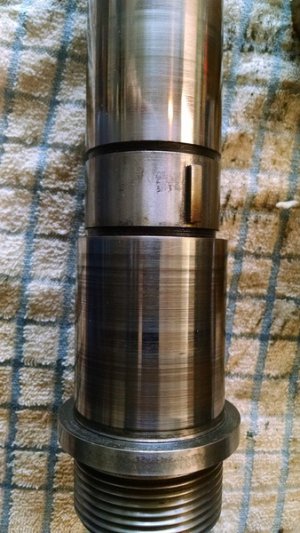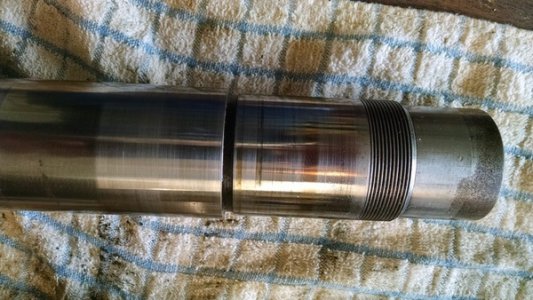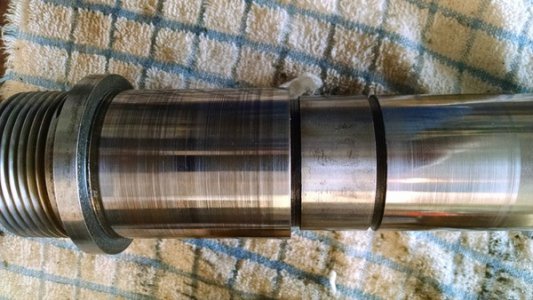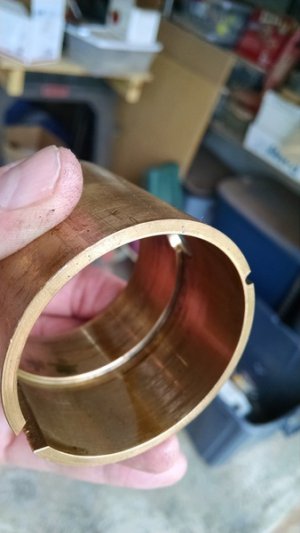- Joined
- Jan 17, 2012
- Messages
- 33
Update: 30JUL16 Spindle is back in the lathe and running fine. Thanks
This is long winded but I want to explain what I have done so far. There are questions at the end.
Here is where I started. I have a South Bend 10L made late 1960 or early '61. The leather belt drive appears to be old and stretched. It ran in back gear okay but the belt slips on the pulley otherwise. I added tension to the belt but not much improvement. I figure I need to replace the belt.
I wanted to be sure the lathe was properly lubricated. I acquired new wicks, felt and laminated shims for the spindle bearings. I started by removing the drain plugs and found there was very little oil in them. I loosened the locking ring at the outboard end of the spindle and backed it off about 1/16”. (I found there were no plugs over the expander screws). I back out the expander screws and then removed the socket cap screws and lifted the bearing caps off. There were full profile shims on the outboard bearing and pieces of shims on the other bearing. I removed what was left of the wicks.
I did not dis-assemble the spindle. I wiped all surfaces on the spindle and set it aside. I then cleaned up the bearing seats and caps. I made sure the passages were clear, I poured mineral spirits through the passages and passed a pipe cleaner through as well. I replaced the drain plugs.
After wiping spindle oil on the bearing surfaces, I placed the spindle back into the casting using wires to retain the wicks. I realized then, even without installing the caps the spindle was stiff to rotate. (I was gripping the bull gear and the nose) I lifted out looked for a problem, saw nothing obvious and then placed the spindle back into the casting. Still hard to rotate.
Following the spindle re-assembly procedures, I peeled off laminations of shims and achieved .0015” play at the nose and .001 at the outboard. (My indicator reads in .0001” increments.)
I refilled the oil reservoirs with spindle oil. I installed the 6” chuck and I can turn the spindle using the chuck wrench for leverage. It will run in back gear as before. After 5 minutes of run time the bearing caps were slightly warm to the touch. Tested again at 15 minutes and thirty minutes. Never got so warm that I couldn't leave my hand on it.
Gary
This is long winded but I want to explain what I have done so far. There are questions at the end.
Here is where I started. I have a South Bend 10L made late 1960 or early '61. The leather belt drive appears to be old and stretched. It ran in back gear okay but the belt slips on the pulley otherwise. I added tension to the belt but not much improvement. I figure I need to replace the belt.
I wanted to be sure the lathe was properly lubricated. I acquired new wicks, felt and laminated shims for the spindle bearings. I started by removing the drain plugs and found there was very little oil in them. I loosened the locking ring at the outboard end of the spindle and backed it off about 1/16”. (I found there were no plugs over the expander screws). I back out the expander screws and then removed the socket cap screws and lifted the bearing caps off. There were full profile shims on the outboard bearing and pieces of shims on the other bearing. I removed what was left of the wicks.
I did not dis-assemble the spindle. I wiped all surfaces on the spindle and set it aside. I then cleaned up the bearing seats and caps. I made sure the passages were clear, I poured mineral spirits through the passages and passed a pipe cleaner through as well. I replaced the drain plugs.
After wiping spindle oil on the bearing surfaces, I placed the spindle back into the casting using wires to retain the wicks. I realized then, even without installing the caps the spindle was stiff to rotate. (I was gripping the bull gear and the nose) I lifted out looked for a problem, saw nothing obvious and then placed the spindle back into the casting. Still hard to rotate.
Following the spindle re-assembly procedures, I peeled off laminations of shims and achieved .0015” play at the nose and .001 at the outboard. (My indicator reads in .0001” increments.)
I refilled the oil reservoirs with spindle oil. I installed the 6” chuck and I can turn the spindle using the chuck wrench for leverage. It will run in back gear as before. After 5 minutes of run time the bearing caps were slightly warm to the touch. Tested again at 15 minutes and thirty minutes. Never got so warm that I couldn't leave my hand on it.
- Does is it sound like the spindle bearing adjustment is normal?
- If it is too tight, what sort of damage am I creating?
- Would you replace the belt and run with it providing it drives the higher speeds?
Gary
Last edited:

